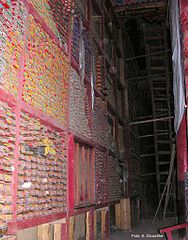Buddhistische Literatur: Unterschied zwischen den Versionen
Adm1 (Diskussion | Beiträge) |
Adm1 (Diskussion | Beiträge) |
||
| Zeile 49: | Zeile 49: | ||
* [//www.thlib.org/encyclopedias/literary/canons/ngb/ The Collected Tantras of the Ancients] | * [//www.thlib.org/encyclopedias/literary/canons/ngb/ The Collected Tantras of the Ancients] | ||
* [//www.thlib.org/encyclopedias/literary/canons/ngb/catalog.php#cat=tk Degé Edition of The Collected Tantras of the Ancients] | * [//www.thlib.org/encyclopedias/literary/canons/ngb/catalog.php#cat=tk Degé Edition of The Collected Tantras of the Ancients] | ||
* Rywiki : [http://rywiki.tsadra.org/index.php/Thirteen_Great_Scriptures 13 great scriptures] | |||
* [//earlytibet.com/about/whereabouts/ The Whereabouts of the Tibetan Manuscripts from Dunhuang] | * [//earlytibet.com/about/whereabouts/ The Whereabouts of the Tibetan Manuscripts from Dunhuang] | ||
* [//web.archive.org/web/20091026210552/http://www.geocities.com/kavitayan/charyagiti.html The Charypada] | * [//web.archive.org/web/20091026210552/http://www.geocities.com/kavitayan/charyagiti.html The Charypada] | ||
Version vom 30. September 2016, 14:12 Uhr
In den ersten Jahrhunderten wurden Buddhas Lehrreden auswendig gelernt.
Die buddhistische Literatur und die buddhistische Philosophie entstanden erst Jahrzehnte nach Buddha, begleitet von immer wieder auftauchenden Streitigkeiten über die Authentizität der Schriften.
Zum heutigen Theravada gehören
- Das Vinayapitaka(Korb der Disziplin), der erste Teil des Tipitaka
- Die Lehrreden bzw. der Suttapitaka, der zweite Teil des Tipitaka
- Der Pali - Kanon bzw. der Tipitaka- Dreikorb
- Das Visuddhi-Magga
Zum Mahayana-Buddhismus(Großes Fahrzeug bzw. Großer Weg) gehören
- Die Mahayana-Sutras entstanden ab dem 1. Jahrhundert v. Chr.
- Die Schriften und Gemälde wie das Diamant-Sutra aus den Höhlenfunden von Dunhuang[1].
- Die tantrischen tibetischen Vajrayana - Schriften
Weitere Schriften der Übersetzung der Lehre sind das tibetische Kangyur[2] und der chinesische Kanon(San zang).
Verbreitete tantrische Schriften sind das Nyingma Gyübum, der 'Ozean der Methoden des Erreichens', das Drup Thab KUuntu(14 Bände) und das Gyu De Kun Tus(30 Bände).
Andere tibetische Schriften sind z.B. das tibetische Totenbuch.
Die buddhistische Mahāvyutpatti (von Sanskrit mahā „groß“, vyutpatti „Ableitung, Etymologie“) entstand um 810 in dem Bestreben, eine standardisierte tibetische Terminologie für Sanskrit-Begriffe zu schaffen. Im Laufe der Teit entstanden weitere Ausgaben mit Übersetzungen ins Chinesische, Mongolische und Mandschurische.
Literatur
- Tarthang Tulku: The Nyingma edition of the sDe-dge bKa'-'gyur/bsTan-'gyur. Dharma Publ., Oakland 1980
- Buddhist Scriptures in Multiple Languages
- Literaturquellen
- Dharmadata - Texte
- en Wiki : Buddhist Texts
- The Sanskrit Text Archives - The Buddhist Texts
- Dictionary of proper Pali names
- Sacred books of the buddhists
- BDK : Mahayana texts
- Buddhanet : Ebooks
Referenzen
Weblinks
- Wiki über Buddhistische Literatur
- Wiki über Tibetische_Literatur
- Wiki zum buddhistischen Kanon
- Rigpawiki : Nyingma Gyübum
- The Collected Tantras of the Ancients
- Degé Edition of The Collected Tantras of the Ancients
- Rywiki : 13 great scriptures
- The Whereabouts of the Tibetan Manuscripts from Dunhuang
- The Charypada
- Digital sanskrit buddhist canon
- The Vajrayana archive
- Buddhasutra - collection
- Tibetan Literature: Studies in Genre
- Sanskrit buddhist texts
- The Vinaya
- Tibetan buddhist resource center
- King Gesar : The worlds largest epic
<historylink type="back" style="font-family: Arial, Helvetica, sans-serif;
font-size: 14px; color: #ffffff; padding: 4px 8px; float:right;
background: -moz-linear-gradient( top, #fcf9fc 0%, #6a75eb);
background: -webkit-gradient( linear, left top, left bottom,
from(#fcf9fc), to(#6a75eb));
-moz-border-radius: 30px; -webkit-border-radius: 30px;
border-radius: 30px; border: 3px solid #ffffff;
-moz-box-shadow: 0px 3px 11px rgba(240,237,240,0.5),
inset 0px 0px 1px rgba(000,145,255,1);
-webkit-box-shadow: 0px 3px 11px rgba(240,237,240,0.5),
inset 0px 0px 1px rgba(000,145,255,1);
box-shadow: 0px 3px 11px rgba(240,237,240,0.5),
inset 0px 0px 1px rgba(000,145,255,1);
text-shadow: 0px -1px 0px rgba(000,000,000,0.2),
0px 1px 0px rgba(255,255,255,0.3);"
> zurück </historylink>
